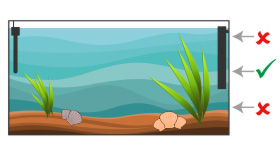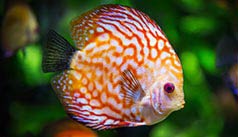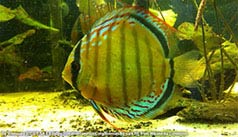

Alternative species (click on the thumbnail to see the card)
Names
Scientific name
Symphysodon discus
Common name
Red Discus
Heckel discus
Pompadour Fish
Origin

Origin: South America (Amazonia)
Biotope: Amazonian
Dimorphism

The shape of the fins is rounder in females
Group

Cichlidae
Volume

450 L / 100 imp gal / 120 US gal
Parameters

T°: 27 to 30°C or 81 to 86°F
pH: 6 to 7
Hardness: 65 to 12°dGH
Difficulty

Hard
Size

15 to 20cm (6 to 8")
Longevity

15 years
Living zone

Middle
Individuals

6
Food
How to feed the Red Discus?
Food
How to feed the Red Discus?
The Discus food is one of the keys to the success of its aquarium maintenance.
It is therefore essential to treat it well. The Discus is essentially carnivorous and will have a clear preference for live or frozen prey. Plan to feed it twice a day, varying as much as possible its food (this will promote its health and growth). Always check that each of your fish has had access to their ration because the dominant of the group could starve others if you are not vigilant.
Note that the higher the temperature of the tank will be hot, and the higher the nutritional needs of the Discus will be, because it will consume more energy.
Similarly, when young, the growing Discus will need abundant and varied food.
Behavior
What kind of behavior does the Red Discus have?
Behavior
What kind of behavior does the Red Discus have?
Despite its size, the Discus is very fearful in nature. It will prefer to live near a root to feel safe. The Discus will be peaceful with the other fish. It can stress very quickly and easily.
As a good cichlid, Discus will still be territorial and hierarchical. Thus, within a group, it can be aggressive towards its congeners. You will easily observe the dominance of an individual over the rest of the group. Despite this, this fish remains a gregarious animal that absolutely needs to live in a shoal.
Cohabitation
Who can live with the Red Discus?
Cohabitation
Who can live with the Red Discus?
Because of its shyness, never associate it with fish species that are too bright or too restless. Instead, choose fish that will live in the middle or bottom of the aquarium. For example, choose species like Red Neon, Penguinfish, Otocinclus or groundfish like Corydoras. They will all make good roommates for your Discus.
Beware of the cohabitation with shrimp, risky enough!
Breeding
How to breed the Red Discus?
Breeding
How to breed the Red Discus?
The breeding of this species is very difficult.
Contrary to what one can read regularly, Discus are not monogamous. So you can choose the fish that interest you for breeding. Note that a young fish can take up to a year to reach sexual maturity.
The breeding of the Discus is fascinating. Before it starts, you will notice quarrels within the group. Note that breeding is common in the community aquarium but rarely achieved. To succeed, install a tank of at least 100 liters or 22 Imp Gallons or 25 US Gallons specially prepared for the breeding. The key to success is in the water parameters, which must remain very stable: temperature above 27°C or 80°F, KH less than 5, nitrates less than 3 mg/l, conductivity at 150/250 microsiemens. To obtain these parameters, the use of osmosis water is essential.
Put in this tray a spawning cone that you will find easily in stores (a little trick: if you have a terracotta pot, turn it over and it will very easily replace the spawning cone). Make sure that the water parameters are the same as in the main aquarium. If you do not install a plant in this breeding tank and prefer to leave it empty, sift the light strongly to reduce the stress of your couple. Isolate the couple in this aquarium. If they like it, laying will be frequent.
Breeding begins with careful cleaning of the nesting rack by the parents. The female will then deposit its eggs starting from the bottom while going up. The male will follow it ready and perform the same movements up and down to fertilise the eggs.
Once the spawning is over, the couple will protect the nest and clean up their eggs. After hatching, the small fry will feed on a very nutritious mucus that will secrete their parents for a few days. After 5 days, feed them with freshly hatched Artemia nauplii. After about 20 days, start feeding the pellets fry for Discus babies and straw powder.
During the growth of fry, be sure to monitor the water parameters and cleanliness. The chances of survival will be further optimised if these parameters are as close as possible to the natural environment.
Although laying is regular, the birth and growth of fry remains very difficult.
Its aquarium
Which aquarium for the Red Discus?
Its aquarium
Which aquarium for the Red Discus;?
If you choose Discus, they will be the stars of your aquarium. Your entire tank will have to be reflected around this central species. Indeed, the conditions to be fulfilled are multiple.
For the volume of the tank, 350 liters or 77 Imp Gallons or 90 US Gallons will be the bare minimum to consider. For perfect health, we will try to reproduce as faithfully as possible the water parameters of the natural environment: temperature at 28°C or 82°F, pH at 6/6.5 and hardness at 5.
On the plantation side, floating plants such as Salvinia or Pistia will offer reassuring shading to your Discus.
For more naturalness, you can use small rounded stones alternating with Anubias at the bottom of your aquarium. Finally, great roots where Discus can hide will greatly favor the serenity of these shy.
Finally, the power of filtration should be 2 to 3 times the volume of the aquarium (value for 1 hour). Indeed, insufficiently filtered water accumulates pollution, which promotes diseases for this fragile fish. Also make water changes very regularly (15 to 20% twice a week) ensuring that the new water has parameters strictly identical to that of the aquarium.
Good To know
Find all additional information!
Good To know
Find all additional information!
A temperature below 26°C or 79°F makes Discus particularly susceptible to diseases.
Discus is particularly prone to intestinal worms. They then develop symptoms such as thinness, loss of appetite, swollen belly, white, filamentous stools, a hollow above the eyes. You can worm them preventively once every three months, with Prescoli or Fluvermal to limit or prevent attacks.
Generally commercially purchased Discus are 6 to 10 centimeters or 2 to 4 inches. At this size, they are still very young and growing. You will therefore need to redouble attention as soon as they are acquired, and especially in terms of food (just like children, they need balance and variety!).
There are actually 3 species of Discus: Symphysodon Discus (described here), Symphysodon Aequifasciatus which is the most widespread species in the aquarium (with at least 4 dark bands on the body, this variety is divided into 3 other subspecies), Symphysodon Tarzoo (slightly smaller, with red dots on the anal fin and on the body).
Yours photos!
Comments
Sort by:
Please login to post comments



